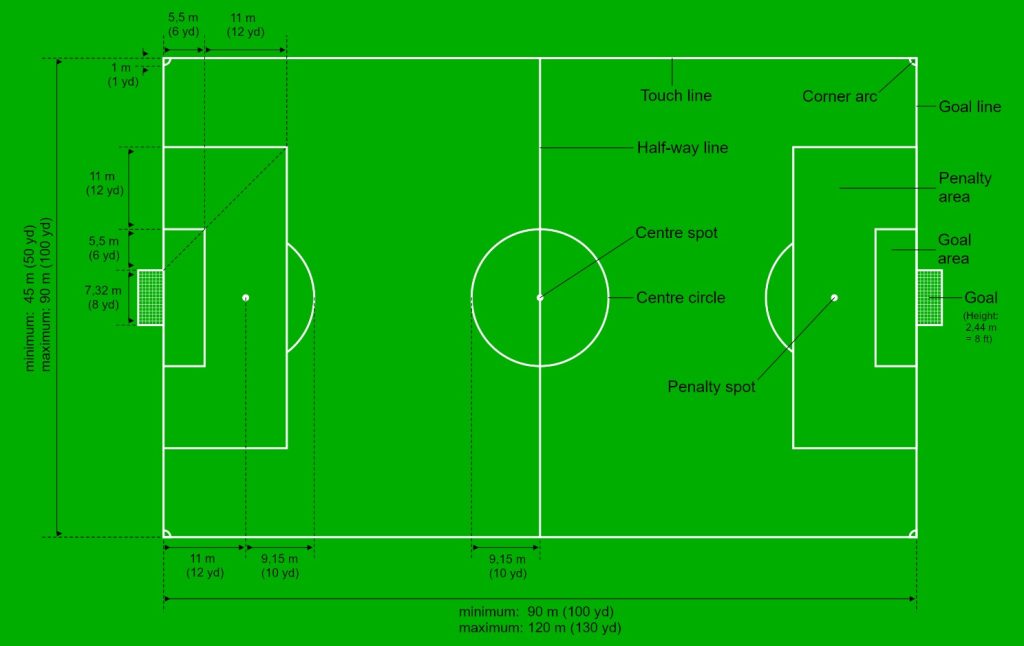Football Ground Measurements: A Comprehensive Guide: Football, known as soccer in some parts of the world, is played on a rectangular field known as a pitch. Understanding the dimensions and measurements of a football ground is essential for players, coaches, and fans alike. This guide provides a detailed overview of the standard measurements, including the pitch, goals, and other critical areas on the field.
1. Dimensions of the Pitch
The standard dimensions of a football pitch can vary, but they generally fall within specific ranges established by FIFA. For international matches, the length of the pitch must be between 100 meters (110 yards) and 110 meters (120 yards), while the width must be between 64 meters (70 yards) and 75 meters (80 yards).
For non-international matches, the length can be between 90 meters (100 yards) and 120 meters (130 yards), and the width can vary from 45 meters (50 yards) to 90 meters (100 yards). This flexibility allows for variations in pitch size depending on the level of play and local regulations.
2. Center Circle and Halfway Line
The center circle is a critical feature of the pitch. It has a radius of 9.15 meters (10 yards) from the center mark. This area is important during kick-offs, as players must remain outside the circle until the ball is in play.
The halfway line divides the pitch into two equal halves. It runs parallel to the goal lines and stretches from touchline to touchline, marking the center of the field. The center mark is located in the middle of this line and is used for kick-offs.
3. Penalty Area and Goal Area
The penalty area, often referred to as the “18-yard box,” is crucial for determining fouls and penalty kicks. It measures 16.5 meters (18 yards) from the goal line into the pitch and extends 40.3 meters (44 yards) across. Within this area, the goalkeeper is allowed to use their hands, and any fouls committed by the defending team can result in a penalty kick.
The goal area, also known as the “six-yard box,” measures 5.5 meters (6 yards) from the goal line into the pitch and extends 18.32 meters (20 yards) across. This area is where goal kicks are taken and where certain rules apply regarding the goalkeeper’s actions during play.
4. Goals
The goals are another critical aspect of the football pitch. A standard football goal measures 7.32 meters (8 yards) wide and 2.44 meters (8 feet) high. The goalposts are positioned at the center of each goal line. The area between the goalposts and under the crossbar is where players aim to score.
5. Corner Arc
Each corner of the pitch features a quarter-circle known as the corner arc. This arc has a radius of 1 meter (1 yard) from the corner flag and is used when taking corner kicks. Players must ensure that the ball is placed within this arc during a corner.
6. Touchlines and Goal Lines
The touchlines are the longer sides of the pitch, while the goal lines are shorter. The dimensions of the pitch are measured between the inner edges of the touchlines and goal lines. The width of the lines themselves is typically around 12 centimeters (5 inches), which is included in the overall pitch dimensions.
7. Additional Markings
Other important markings on the pitch include the penalty spot, located 11 meters (12 yards) from the goal line, where penalty kicks are taken. There are also markings for substitutions and technical areas along the touchlines, designated for team officials.
Understanding the measurements of a football ground is essential for appreciating the game’s structure and flow. From the dimensions of the pitch to the specifics of the goals and penalty areas, these measurements play a crucial role in ensuring fair play and consistency across different levels of the sport. Whether you’re a player, coach, or fan, knowing these details enhances your experience and engagement with football, a sport that unites millions around the world.
Also Read: Most Ducks in IPL













